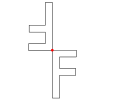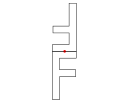Instructor:Rosette Exercises Solutions
From EscherMath
Jump to navigationJump to search
- Castrovalva: We’re not looking for symmetry as much here as we are looking for some hint of a repetitive pattern. There are many possibilities. Here are but a few.
- The clouds
- The windows in the houses on the cliff
- The leaves on the plants in the foreground
- The houses on the bottom right
- The landscape (plots of land on the right)
- The patterns in the side of the cliff
- The trees on the bottom right
- Paradise doesn't have symmetry in the strict sense of the word. The composition is highly balanced though. There is a "vertical mirror line" that runs down the center of the print. The owl and the chimpanzee in the center are drawn with bilateral symmetry. The figure of Adam is balanced by the image of Eve. The camel, tiger and deer on the left are balanced by a bison a lion and a stork on the right.
-
a.
 b.
b.  c.
c.  d.
d. 
-
a.
 b.
b.  c.
c.  d.
d. 
- A regular polygon with n sides has n reflection lines that meet at the center. If n is even, there are lines that go from each corner to its opposite corner, and each side to its opposite side. If n is odd, all lines go from a corner through the midpoint of the opposite side.
- a. Yes; b. No; Neither print has reflectional symmetry. The print on the left (Path of Life I) has 8-fold rotational symmetry, and the print on the right (Path of Life II) has 4-fold rotational symmetry). So they have symmetry groups C8 and C4 respectively.
- There is almost a reflectional symmetry. Every elephant has a corresponding swan, which is located where we would expect to find the reflection of the original elephant. With swans rotating elephants, the left elephant would have to be moved to the right with his trunk curling the other way. Similarly the elephant on the right would be moved to the left, but oriented in the opposite way. (Check that the line drawing is somewhat correct.)
- a. D3; b. D1; c. None; d. D1; e. C3; f. D5
- C4
- C3 or C6 if you ignore the black border triangles - note the crossed arms destroy any mirror symmetry.
- None. Details of arms destroy the mirror symmetry.
- None.
- C5.
- C6.
- C3 or C6 with a color interchange.
-
C1 C2 D1 D2 Not discrete FGJLPR NSZ ABCDEKMQTUVWY HIX O - C2 symmetry is strongly suggested. A 180° rotation interchanges the devil and Jesus. Also, horizontal and vertical reflections change the figures with the goats. Jesus was a scapegoat - a symbol of blame for the problems of his society. Escher suggests the Devil was instrumental in his scapegoating.
- C4. Overlaps prevent D4. The center portion has C8 or even C16 depending on how much you ignore.
- C4. Preserving colors reduces to C2.
- D3.
- C2 is strongly suggested, though not precisely present.
- C3 is strongly suggested.
- C2 symmetry interchanging colors. No color preserving symmetry.
- There is a suggestion of a color interchanging D1 symmetry. But the two sides are not quite the same. (There are also points which are almost centers of C2 symmetry, if only the birds are considered.)
- Group is C3. Nine impressions - three of each color.
- Draw C2-C6, D2-D6 with a motif.
- Two rotation centers
- This poem can be read normally, or by reading each column of words downwards.
- Many answers. D2 symmetry is more or less impossible, because you can only use H, I, and O.
- 1. D3; 2. D2; 3. D2; 4. D3; 5. D5;
6. D3; 7. D4; 8. D2; 9. D4; 10. D2;
11. D4; 12. D2; 13. D5 (D10 if you ignore color); 14. D2; 15. D2;
16. D22; 17. D4; 18. D2; 19. D2; 20. D2;
21. D1; 22. D3. - a) D1, D4, D5, D6, D7, D8, D9. b) D2 and D3 are missing. c) Probably draw a nice symmetric 3 point star to get D3.
- C3, C4, C5, C6, and C12 all appear.